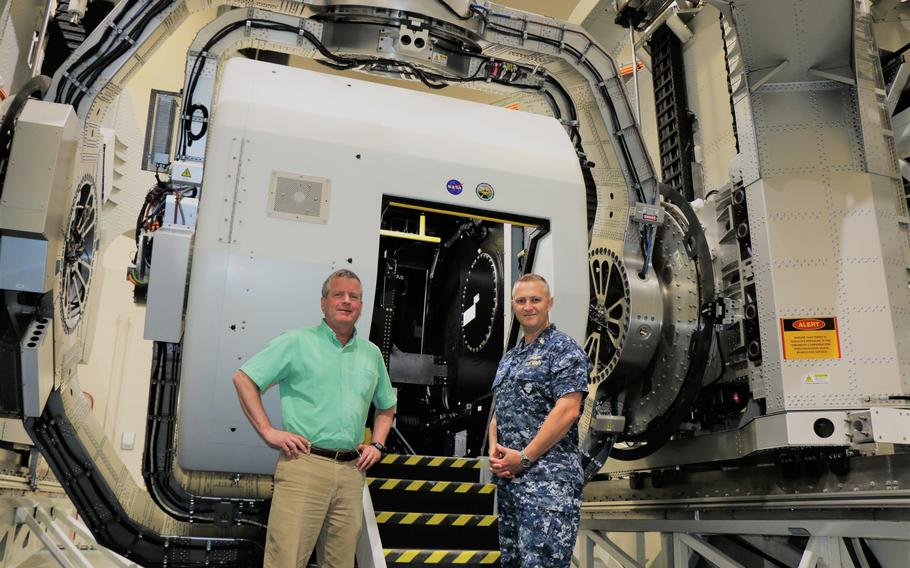
Naval Medical Research Unit Dayton’s Senior Research Psychologist Dr. Henry Williams (left) and Capt. Richard Folga, Naval Aerospace and Operational Physiologist, Disorientation Research Device (DRD) Program Manager and Engineering and Technical Support Services Department Head stand near the DRD. The DRD, or the Kraken, is the Navy’s aerospace medicine research device. (Megan Mudersbach/U.S. Air Force)
(Tribune News Service) — Dayton, Ohio, has always been an Air Force town. But thanks to the productive presence of a cadre of U.S. Navy researchers, it's more than that.
The Navy presence at Wright-Patterson Air Force Base did not begin with the Base Realignment and Closure process in 2005. The Navy was here long before that, said Capt. Walter Dalitsch III, commander of the mission sometimes called "NAMRU (Navy Aerospace Medical Research Unit) Dayton" or simply "NAMRU-D."
"We have had a Navy presence here since 1976," said Dalitsch, whose O-6 rank as captain is equivalent to an Air Force colonel.
A Navy toxicology unit was moved to Wright-Patterson from Washington, D.C., in 1976 to partner with a similar Air Force lab, he said. An environmental health lab was already here when the 2005 BRAC outcome began the process of moving another Navy science lab, the Naval Aerospace Medical Research Lab, to Wright-Patterson, although initially not as a full command.
"Then the decision was made, 'Well, why don't we combine the environmental health effects laboratory with the Naval Aerospace Medical Research Lab and call it a whole new command?'" Dalitsch said.
The result was NAMRU Dayton Medical Research Unit.
There are some 150 people working at the command, although contractor numbers fluctuate.
"The vast majority are civilians and brilliant scientists," Dalitsch said.
Together, they research human performance — helping aviators and others work at their peak in stressful and varied environments, from jet cockpits to aircraft carriers to submarines.
They study toxins and co-stressors and the "combination effect" of both, exploring, for example, what happens when a sailor is exposed to both jet fuel and loud noises at the same time. Will such an environment make hearing loss worse faster?
One recent NAMRU customer: The U.S. Coast Guard.
The Coast Guard had a problem with laser pointers aimed at aircraft, Dalitsch said. When such lasers hit cockpit glass, they can dazzle and temporarily blind pilots.
"The Coast Guard was getting lasered on some real-world search-and-rescue missions and having to wave off in the middle of trying to save a life," he said.
NAMRU, in response, developed spectacles that cut out the wavelength of the most common lasers — and yet still allow color vision "to be able to see the instruments on the (plane) instrument panel," he said.
Those glasses are now used by the Coast Guard fleet and are going through a Federal Aviation Administration (FAA) approval process.
While the Navy isn't new at Wright-Patterson, the service's presence there can take even people familiar with the base by surprise.
"Oh, people are surprised all the time. I tell people I feel like an aircraft carrier out of water here," Dalitsch quipped.
Friends of the mission say it's the partnership on mutual problems with the Air Force Research Laboratory (AFRL) that makes it truly special.
AFRL and NAMRU are neighbors and kindred spirits on Wright-Patterson's Area B, home to a variety of research missions.
Corey Hart, who is the lead on the biomedical impact of air and space with AFRL's 711th Human Performance Wing, said those benefits go beyond shared research assets, such as the "Kraken," the GL-6000 Disorientation Research Device that creates realistic motion simulations.
"Those assets are great, but really what we value is the shared expertise, and that covers a very broad area," Hart said.
The Navy has leading experts in sensor validation work — work on sensors meant to assist pilots in harsh environments — and other areas.
And there is attention paid to make sure research isn't duplicated, to be efficient with taxpayer dollars, he said.
"We have a strong partner there to lean on for solutions," Hart said.
It's not Dalitsch's first time on an Air Force base. He directed the Department of Defense Medical Examination Review Board, which happens to be at the Air Force Academy in Colorado. "It's not the first time the Navy has sent me far from the ocean."
NAMRU has repeat customers, including the FAA, the Office of Naval Research, the Defense Health Agency and NASA.
Like AFRL, NAMRU and its predecessor units have worked with NASA since it was NACA in the 1950s, the captain said. That history of cooperation stretches back to the Mercury, Gemini and Apollo programs. And researchers both at NAMRU and AFRL are working today with NASA's Artemis program.
Said Dalitsch: "That's why we get repeat customers, because our product is pretty good."
NAMRU staff have more than doubled since 2011. Research spending has nearly tripled. And the unit's "science output" has increased nearly sevenfold, the commander said.
"I walk around and I'm surrounded by people with so many degrees," he said. "I'm just humbled by the brilliant ideas and the work that they do here."
(c)2022 Springfield News-Sun, Ohio
Visit at www.springfieldnewssun.com
Distributed by Tribune Content Agency, LLC.